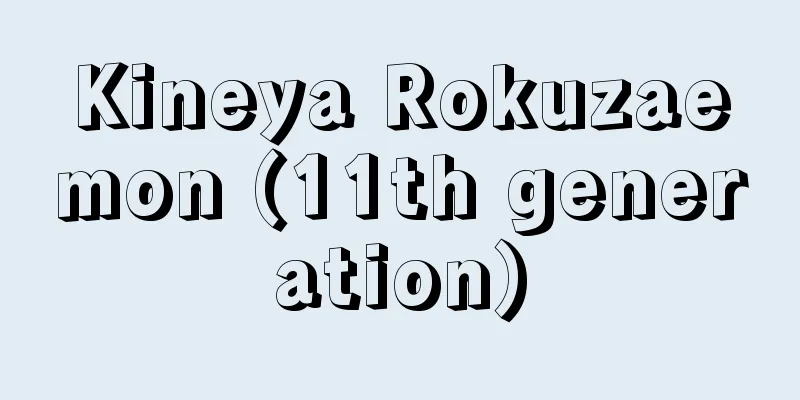Apartheid - Apartheid (English spelling)

|
Afrikaans (the official language of the Republic of South Africa) is the English word for "apartness." The former Union of South Africa and its successor, the Republic of South Africa, had a policy of racial apartheid that discriminated against the relationships between whites and non-whites (blacks, Asians from India, Pakistan, Malaysia, etc., and mixed-race residents known as coloreds). It was legally abolished in 1994 with the collapse of the white national system. [Jiro Suzuki] ContentsAlthough the content of this policy is basically from the 17th century, the term, which first appeared in the Natives Land Act of 1913, began to be widely used as a comprehensive term for the country's racial segregation policies after 1948, when the National Party (NP) strengthened racial discrimination institutionally. However, the government later renamed it the Separate Development Policy. The reason for this was to reduce the dark image of apartheid. According to the government, the government publicly claimed that races and tribes with different traditions, cultures, languages, etc. should be separated into separate regions and societies, each of which should live its own life and develop independently, but its true aim was to maintain the political rule of a small number of white people and to supply cheap labor from non-whites. The Bantustan (Homeland) policy implemented in 1971 forced the vast majority of black people to live in 10 ethnically-based residential areas in the barren, remote area that made up only 13% of the country's land area, and gave them nominal autonomy. Eventually, as an independent country in name only, South African citizenship was stripped away, and black people were forced to depend economically on whites and treated as foreign migrant workers. Despite opposition from black people, the four regions of Transkei, Bophuthatswana, Venda, and Ciskei were given "independence" (1976-1981), but they were not internationally recognized as independent countries. In addition, policies that discriminated against non-whites in every aspect of daily life, such as voting rights, forming political parties and unions, residence, marriage and sexual relations, employment, wages, education, medical care, religion, public facilities, entertainment, and sports, were institutionalized in countless laws and practices. [Jiro Suzuki] Resistance and repressionOf course, there was a strong resistance movement within the country and support from abroad, but opposition and violations were severely punished by oppressive laws and social sanctions by custom. The outlawing of resistance organizations, deaths and imprisonment due to oppression, detention without warrants, and exile were commonplace. International public opinion against this was harsh. This was shown in part by the economic sanctions resolutions imposed by the United Nations, the de facto banning of South Africa from the UN, the establishment of the UN's "Day for the Elimination of Racial Discrimination" (March 21st) to commemorate the Sharpeville Massacre in 1960, the policies of Commonwealth member countries that forced the Union of South Africa to withdraw from the Commonwealth and establish the Republic of South Africa (1961), and the boycott of South Africa in sports. The combination of international public opinion and domestic resistance put pressure on South Africa's political and financial circles, and the South African government decided to abolish apartheid in order to avoid isolation from the international economy. As a result, some of the apartheid restrictions began to be relaxed, such as restrictions on occupations, trade union registration, use of public facilities and entertainment facilities, education fees, and participation in sports teams. However, these measures continued to divide Asian residents, Coloureds and Blacks. [Jiro Suzuki] The collapse of the apartheid regimeAfter the Sharpeville incident in 1960, the South African government outlawed the African National Congress (ANC) and the Pan Africanist Congress (PAC), and promoted a policy of segregation and development for blacks through the Bantu Homelands Citizenship Act of 1970 and the Bantu Homelands Constitution of 1971. Meanwhile, the right to vote was restored to Coloureds and Indians by introducing a racial ternary parliament in 1984. The establishment of this racial ternary parliament led to an intensification of anti-government movements among blacks. The South African government issued a state of emergency in some areas and suppressed the movement, which drew criticism from the international community and led to the strengthening of economic sanctions against South Africa. As a result, the Botha National Party government abolished the Mixed Marriages Prohibition Act and the Immorality Act in 1985 and the Pass Laws the following year in 1986, but at the same time expanded the state of emergency to the entire country and suppressed anti-government movements. De Klerk, who became president in September 1989, changed the policy of the previous National Party (NP) government and adopted a "dialogue approach" to decide the future of South Africa through negotiations with black people. Based on this policy, in February 1990, the ANC, PAC, and the South African Communist Party were legalized, and ANC leader (later president) N. Mandela was released from prison. In May of the same year, the South African government held preliminary negotiations with the ANC, and in June the state of emergency was lifted. As a result, the ANC declared an end to armed struggle. In February 1991, President de Klerk declared in his opening speech to Parliament that all apartheid laws would be abolished, and in June the Population Registration Act, Natives Land Act, and Group Areas Act were abolished. In response to this move by the South African government, the EC (European Community, later the EU), the United States, and Japan lifted their economic sanctions one after another. Next, the Democratic South Africa Conference was held in December 1991 and May 1992, with the participation of all 18 political parties and organizations, to discuss the political system of South Africa after the abolition of apartheid. However, during these negotiations, armed clashes between ANC-affiliated organizations and the Zulu-based Inkatha Freedom Party (IFP) occurred frequently in Transvaal Province (now Gauteng Province, etc.) and Natal Province (now KwaZulu-Natal Province), resulting in many casualties, and the negotiations were often suspended or postponed. However, in April 1993, a multi-party negotiating forum was held, with the participation of 26 political parties and organizations. This forum led to the establishment of a transitional government in December of the same year, with the participation of all political parties and organizations, as a transitional political system until the election, and at the same time, a transitional constitution was enacted. Based on this transitional constitution, the first all-race constituent assembly election in South Africa's history was held in April 1994, and Mandela's new government was established in May. [Akifumi Hayashi] South Africa after democratizationBased on the power-sharing clause of the interim constitution, the Mandela government became a coalition government with the ANC, the National Party, and the Inkatha Freedom Party. In the political sphere, President Mandela called for ethnic reconciliation and cooperation, and in the economic sphere, he aimed to correct the disparity between whites and blacks that occurred under the apartheid regime and to recover from the economic recession caused by economic sanctions. In order to achieve ethnic reconciliation and cooperation, the Truth and Reconciliation Commission was established in December 1994 to clarify the truth of the political oppression and human rights violations under the apartheid regime and to restore the rights of the victims. Public hearings were held, and the truth was revealed one after another. Meanwhile, in accordance with the provision of the interim constitution that a new constitution be enacted within two years, a constituent assembly was established in May 1994. The focus was on whether to have a centralized or decentralized state, and the Inkatha Freedom Party, which advocated the latter, withdrew from the constituent assembly. Then, in the new constitution adopted in May 1996, the power-sharing clause was deleted, and the National Party withdrew from the coalition government. In terms of economic policy, the Reconstruction and Development Plan (RDP) was implemented, which was centered on both wealth redistribution and economic growth, but delays in the development of implementation mechanisms, lack of financial resources, and lack of human resources delayed the implementation of redistribution in particular, and dissatisfaction with the new black government grew. For this reason, in June 1996, the government announced the Growing Armed Macroeconomic Growth and Economic Alliance (GEAR), which placed emphasis on economic growth, and attempted to solve the redistribution problem through high economic growth rates. This change in policy was welcomed by the white South African business community, but was strongly criticized by black South Africans as a departure from the RDP. Meanwhile, the final report of the Truth and Reconciliation Commission, chaired by Archbishop Tutu, was published in October 1998. The report identified individuals and groups that had committed human rights violations and called for criminal prosecution of the perpetrators. Despite the implementation of the RDP and GEAR, the recovery of the South African economy was slow, and the problem of unemployment, particularly among blacks, remained unresolved. This resulted in an intensification of social crime, which became a major reason why developed countries were unable to invest in South Africa and why companies were unable to enter the country. Under these circumstances, the second general election was held in June 1999, and the ANC won again, leading to the inauguration of the Thabo Mbeki (1942- ) government. Mandela took this opportunity to retire from politics. Mbeki continued to push forward with GEAR, and after the end of the Cold War, he came up with the idea of an African Renaissance, which aimed to revitalize the increasingly marginalized African continent through trade and investment rather than aid. [Akifumi Hayashi] "The System and Reality of Apartheid" by Roger Omond, translated by Saito Kenji (1989, Iwanami Shoten)" ▽ "The Road to Freedom - The Autobiography of Nelson Mandela, Volumes 1 and 2 (1996, NHK Publishing)" ▽ "Inside Story of the Republic of South Africa - Until the End of Apartheid" by Ito Masataka (Chuko Shinsho) [References] | | | | | | | | | |Source: Shogakukan Encyclopedia Nipponica About Encyclopedia Nipponica Information | Legend |
|
英語の「分離」(apartness)にあたるアフリカーンス語(南アフリカ共和国の公用語)。かつての南アフリカ連邦、およびこれを継承した南アフリカ共和国における白人と非白人(黒人、インド、パキスタン、マレーシアなどからのアジア系住民や、カラードとよばれる混血住民)の諸関係を差別的に規定する人種隔離政策であったが、1994年白人国家体制の崩壊とともに法律上は廃止された。 [鈴木二郎] 内容その内容は基本的には17世紀以来のものであるが、1913年の原住民土地法に登場したこの用語が、同国の人種隔離諸政策を包括する用語として広く使われ始めたのは、国民党(NP)が人種差別を制度的に強化した1948年以降である。しかし政府はその後これを分離発展政策とよびかえた。その理由は、アパルトヘイトのもつ暗いイメージを軽減することにあった。政府によれば、伝統、文化、言語などの違う人種や種族は、それぞれ別の地域と社会に分離して、それぞれが固有の生活を営みつつ独自に発展すべきであると表向きには主張したが、その真のねらいは、少数の白人による政治的支配を維持し、安価な労働力を非白人から供給することにあった。1971年に実施されたバントゥスタン(ホームランド)政策は、絶対多数の黒人を、国土の13%にすぎない辺境不毛の地に設けた種族別の居住地域10地区に住まわせ、名目上の自治権を与えて、最終的には名目だけの独立国として南ア市民権を奪い、経済的には白人に依存せざるをえない黒人を外国籍の出稼ぎ労働者として扱おうとするものであった。黒人の反対にもかかわらず、トランスケイ、ボプタツワナ、ベンダ、シスケイの4地区は「独立」(1976~1981)させられたが、国際的には独立国として承認されなかった。そのほか、参政権、政党・組合の結成、居住、結婚と肉体交渉、就職、賃金、教育、医療、宗教、公共施設、娯楽、スポーツなど、日常生活の隅々にわたって非白人を差別する政策が、無数の法と慣行で制度化されていた。 [鈴木二郎] 抵抗と弾圧もちろん国内での抵抗運動と海外からの支援は活発であったが、反対や違反は弾圧法規によって厳しく処罰されたり、慣行によって社会的制裁を受けた。抵抗組織の非合法化、弾圧による死亡・投獄、令状なしの拘留、亡命が日常茶飯事であった。これに対する国際世論は厳しかった。その一端は、国連における経済制裁決議、実質的な国連からの締め出し、および1960年のシャープビル大虐殺(シャープビル事件)を追悼する国連による「人種差別撤廃の日」(3月21日)制定、また南アフリカ連邦を、イギリス連邦からの脱退と南アフリカ共和国創建(1961)に追い詰めたイギリス連邦加盟諸国の政策、さらにスポーツ界の南ア・ボイコットなどに示された。 こうした国際世論と国内での抵抗が相まって南アの政財界を追いつめ、南ア政府は国際経済からの孤立を避けるためにアパルトヘイトを廃止する方向に踏み切った。この結果、制限職種、労働組合の登録、公共施設や娯楽施設の利用、教育費、スポーツチームへの参加などにおいてアパルトヘイトの一部が緩和され始めた。しかしこれも、アジア系住民、カラードと黒人を分断する方策がつねに講じられてきたのである。 [鈴木二郎] アパルトヘイト体制の崩壊南アフリカ政府は、1960年のシャープビル事件後アフリカ民族会議(ANC)とパン・アフリカニスト会議(PAC)を非合法化し、1970年の「バントゥ・ホームランド市民権法」、翌1971年の「バントゥ・ホームランド制憲法」により黒人の分離発展政策を推し進めた。一方、カラードとインド人に対しては1984年に人種別三院制議会を導入して参政権を復活した。この人種別三院制議会発足を契機に黒人の反政府運動は高まった。南ア政府は一部地域に非常事態宣言を発令して弾圧したため国際社会の非難が起こり、対南ア経済制裁が強化された。このためボータ国民党政権は1985年に雑婚禁止法、背徳法、翌1986年にはパス法を廃止したが、一方では非常事態宣言を全土に拡大し反政府運動を弾圧した。 1989年9月大統領となったデクラークは従来の国民党(NP)政権の方針を転換し、黒人との交渉により将来の南アフリカを決めてゆく「対話路線」をとった。この方針に基づき翌1990年2月にANC、PAC、南ア共産党を合法化し、ANC指導者(のち大統領)N・マンデラを釈放した。続いて同年5月南ア政府はANCと予備交渉を行い、6月には非常事態宣言を解除した。この結果、ANCは武力闘争停止を宣言した。翌1991年2月、大統領デクラークは国会開会演説ですべてのアパルトヘイト法を廃止すると宣言し、6月には人口登録法、原住民土地法、集団地域法を廃止した。南ア政府のこの動きに対して、EC(ヨーロッパ共同体、のちEU)、アメリカ、日本は次々と経済制裁を解除していった。 ついでアパルトヘイト廃止後の南アフリカの政体を話し合うため全18政党・組織が参加した民主南アフリカ会議が1991年12月と翌1992年5月に開催された。しかしこの交渉中、ANC系組織とズールー人を基盤とするインカタ自由党(IFP)との武力衝突がトランスバール州(現ハウテン州など)、ナタール州(現クワズールー・ナタール州)で頻発し多くの死傷者が出、交渉はしばしば中断・延期された。しかし1993年4月に多党交渉フォーラムが開かれ、26政党・組織が参加した。このフォーラムにより選挙までの移行期の政体として全政党・組織が参加した暫定政府が同年12月に発足し、同時に暫定憲法を制定した。この暫定憲法に基づき翌1994年4月、南ア史上初の全人種が参加した制憲議会選挙が実施され、5月にマンデラ新政権が樹立された。 [林 晃史] 民主化後の南アフリカ暫定憲法の権力分与条項に基づきマンデラ政権はANC、国民党、インカタ自由党との連立政権となった。大統領マンデラは政治面では民族和解・協調を呼びかけ、経済面ではアパルトヘイト体制下で起こった白人・黒人間の格差の是正と経済制裁による経済不況からの回復を目ざした。民族和解・協調のためアパルトヘイト体制下の政治的抑圧や人権侵害の真相を明らかにし、被害者の復権を目ざす真実和解委員会が1994年12月に発足し、公聴会が開かれ、次々に真相が暴露されていった。一方、2年以内に新憲法を制定するという暫定憲法の規定に従い、1994年5月制憲議会が発足した。焦点は中央集権国家か地方分権国家かであり、後者を主張するインカタ自由党は制憲議会から脱退した。そして1996年5月に採択された新憲法では権力分与条項が削除されたため、国民党は連立政権から離脱した。経済政策では富の再配分と経済成長を両軸とする復興開発計画(RDP)が実施されたが、実施機構整備の遅れ、財源不足、人材不足からとくに再配分の実施は遅れ、黒人の新政権への不満は高まった。このため1996年6月、政府は経済成長を重視するマクロ経済成長戦略(GEAR)を発表、高い経済成長率によって再配分問題も解決しようとした。 この政策転換に対し、白人の南ア財界は歓迎したが、黒人はRDPからの逸脱として激しく非難した。一方、大司教ツツを委員長とする真実和解委員会の最終報告書は1998年10月に公表された。同報告書は人権侵害を行った人物や団体を指摘し、加害者に対し刑事訴追を要求した。 RDPとGEARの実施にもかかわらず南ア経済の回復は遅く、とくに黒人の失業問題は解決せず、このため社会犯罪が激化し、このことは先進諸国の対南ア投資、企業進出が進まない大きな原因となっている。このような状況下で1999年6月に実施された第2回総選挙で、ANCが再度勝ち、ムベキThabo Mbeki(1942― )政権が発足した。マンデラはこの総選挙を機に政界から引退した。ムベキは引き続きGEARを押し進めるとともに、冷戦終結後、周縁化が進むアフリカ大陸を、援助よりは貿易と投資を通じて活性化させようとするアフリカン・ルネサンス構想を打ち出した。 [林 晃史] 『ロジャー・オモンド著、斎藤健司訳『アパルトヘイトの制度と実態』(1989・岩波書店)』▽『ネルソン・マンデラ著、東江一紀訳『自由への道――ネルソン・マンデラ自伝』上下(1996・日本放送出版協会)』▽『伊藤正孝著『南ア共和国の内幕――アパルトヘイトの終焉まで』(中公新書)』 [参照項目] | | | | | | | | | |出典 小学館 日本大百科全書(ニッポニカ)日本大百科全書(ニッポニカ)について 情報 | 凡例 |
<<: Apparel industry - Apparel industry
>>: Avars - Abar (English spelling)
Recommend
Long pepper
…var. fasciculatum (English name red cluster pepp...
Murcia - Murcia (English spelling)
Murcia is the capital of the province of Murcia, ...
Cypselurus heterurus doederleini (English spelling)
…Most of them spawn in spring and summer, and the...
Hölzel, A.
…German painter and visual artist. After studying...
Murnau - Friedrich Wilhelm Murnau
German film director. His real name was F. W. Plu...
Ason - Asun
{A phonetic change of "asomi." In the Mi...
Body box - Kaitaibako
…The tea boxes favored by early modern tea master...
Cairo Museum - Cairo Museum
This museum is located northwest of Midan Ettahrir...
Urodela
…The tiger salamander family, represented by the ...
Ice axe
…A type of mountaineering equipment used for bala...
Galaxy density distribution map - Gingamitsudobunpuzu
…In 1982, Richard Brent Tully compiled distance d...
Okinawa rail (Okinawa rail) - Okinawa rail (English spelling)
A bird of the family Rallidae (illustration) in th...
Fujiwara no Suenori - The successor to Fujiwara
Year of death: 2.12.2 (1155.12.27) Year of birth: ...
Aroumanian - Aromanian (English spelling)
They speak Aromanian (a dialect of Romanian) and l...
Saint Helena (Island) (English spelling)
An isolated British island in the South Atlantic, ...









